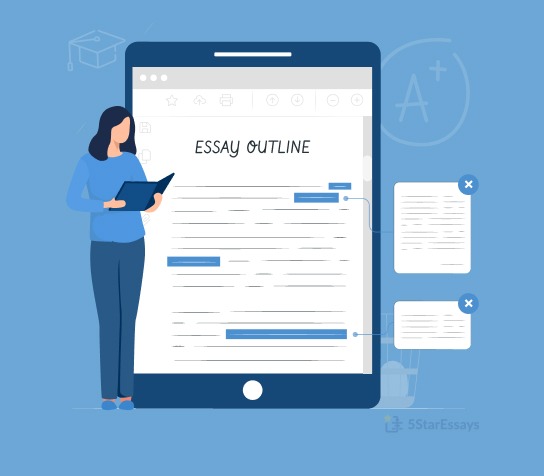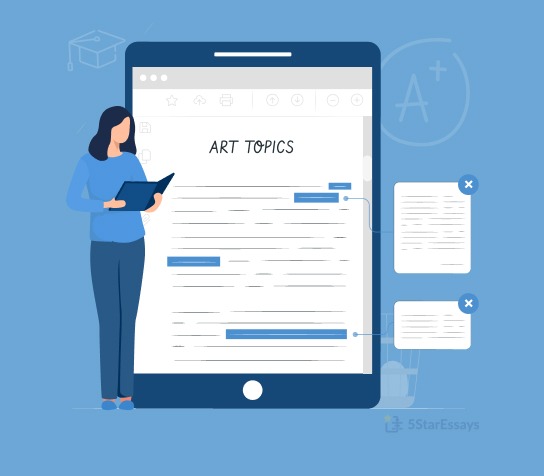Pre-Writing Process: Preparation and Planning
Building a strong foundation is key to crafting a stellar essay. The pre-writing process sets the stage for your essay by focusing on preparation and planning.
Understand the Essay Prompt or Topic
Before diving into the writing process, it is crucial to choose and thoroughly understand the essay topic.
Carefully read and analyze the requirements, instructions, and any specific guidelines provided.
Identify the key components of the prompt, such as:
- The main question or issue to be addressed
- The scope of the topic
- Any specific requirements for the essay
Choose the Type of Essay
The next step is to decide which type of essay you need to write. Choosing the correct type of essay is an important step toward your successful essay.
Here are the main types of essays in which every academic essay can be categorized.
- Descriptive Essay - A descriptive essay discusses the topic in detail so that it becomes easy to understand for the reader.
- Narrative Essay - A narrative essay is a narration of a story in the form of an essay.
- Persuasive Essay - A persuasive essay convinces the reader to accept your perspective about the essay topic.
- Expository Essay - An expository essay explains and clarifies the topic with great details and examples.
Knowing what type of essay you are required to write can help you choose the topic and draft the essay. Here are the other types of essays that you should also be familiar with.
- Argumentative essay
- Analytical essay
- Cause and effect essay
- Classification essay
- Synthesis essay
- Compare and Contrast Essay
Conduct Thorough Research
Once you have a clear understanding of the essay prompt, it's time to gather relevant information through research.
Utilize various sources such as scholarly articles and academic databases to gather information that will support your arguments.
Also decide what type of formatting and citation styles you need for your essay. Generally, the following are some common college essay writing styles for students:
- APA (American Psychological Association) - An Author-Date citation style designed for psychology and social science discipline.
- MLA (Modern Language Association) - An Author-Page number citation style designed for language and humanities disciplines.
- CMS (Chicago Manual of Style) - A Notes-bibliography or Author-Date citation style, also known as Turabian Style. It is applicable to both scientific and non-scientific disciplines.
Create an Outline to Structure Your Essay
An outline acts as a skeleton for your essay, providing a structured framework to guide your writing. It helps you with how to write essay format questions and ensure that your essay flows logically and coherently.
Start by organizing your main ideas or subtopics into sections or paragraphs. Then, under each main idea, list the supporting points, evidence, or examples you will include.
Wondering how to write an outline for an essay? Here is a 5 paragraph essay outline structure.
I. Introduction A. Hook or attention-grabbing statement II. Body Paragraph 1 A. Topic sentence introducing the main point of the paragraph III. Body Paragraph 2 A. Topic sentence introducing the main point of the paragraph IV. Body Paragraph 3 A. Topic sentence introducing the main point of the paragraph V. Conclusion A. Restatement of the thesis statement |
Writing Process: Crafting Your Essay
The writing process includes engaging introduction, body and conclusion. Let’s get through the step by step for crafting each section.
Write the Introduction
An introduction paragraph is the first paragraph of your essay. The purpose of the introduction is to inform your reader about the topic that you will discuss in the essay.
If you are thinking how to write an essay introduction, here is what an engaging introduction includes:
Engaging Hook
To capture the reader's attention from the start, consider using a compelling hook.
This can be a thought-provoking question, a surprising fact, a relevant quote, or an intriguing anecdote.
The goal is to create curiosity and make the reader eager to continue reading.
| Example: "Did you know that the average person spends more time scrolling through social media in a year than they do sleeping? |
Background Information
After grabbing the reader's attention, provide some context or background information related to your essay topic.
This will help the reader understand the significance and relevance of the subject matter.
It can include historical context, relevant statistics, or an overview of the current state of affairs.
| Example: "With the rise of social media platforms, online communication has become the norm for many individuals. People connect, share, and express themselves in ways unimaginable just a decade ago. However, this digital revolution has sparked debates about the impact of technology on human relationships." |
Thesis Statement
Conclude the introduction with a clear and concise thesis statement that encapsulates the main argument or purpose of your essay.
The thesis statement should reflect the stance you will be taking and provide a roadmap for the subsequent body paragraphs.
| Example: "Through an examination of the effects of technology on communication patterns, this essay argues that while digital platforms offer unprecedented connectivity, they can also hinder the development of genuine human connections. By exploring the challenges and benefits of online interactions, we can gain insight into the complex interplay between technology and our social lives." |
Body Paragraphs
Body paragraphs are the linking paragraphs between the conclusion and introduction.
All the information, examples, facts, and details about the topic in this section ultimately support your thesis statement.
Topic Sentences and Supporting Arguments
In each body paragraph, start with a topic sentence that introduces the main point or argument.
Each topic sentence should be clear and specific, guiding the reader on what to expect in the paragraph.
Follow up with supporting arguments or ideas that expand on the topic sentence and provide evidence or examples to support your claims.
Using Evidence and Examples
To strengthen your arguments, include relevant evidence, examples, or data. This could be in the form of research findings, expert opinions, real-life scenarios, or personal experiences.
Ensure that the evidence directly supports your claims and helps convince the reader of your point of view.
Use Clear Transitions
Maintain a logical flow within and between paragraphs by using clear transitions.
Transitions help connect ideas and create a smooth transition from one point to another. This ensures that your essay is cohesive and easy to follow.
Use transition words and phrases such as "furthermore," "in addition," "on the other hand," and "in contrast" to signal shifts in ideas and create a seamless reading experience.
Conclusion
The conclusion is the last paragraph that summarizes the main theme of the essay and its outcomes. It should include:
Summarize Key Points
In the conclusion, provide a brief summary of the key points discussed in the body paragraphs. Remind the reader of the main arguments and evidence presented throughout the essay.
Restate the Thesis Statement
Reiterate the thesis statement but rephrase it or present it in a slightly different manner. This helps reinforce the central message and reminds the reader of the main focus of the essay.
Call-to-Action/ Impression
End the conclusion with a thought-provoking statement or a call to action. This could be a reflection on the broader implications of the topic, a suggestion for further research, or a call to action.
Post-Writing Process: Editing and Refining
After writing your essay, make sure you:
Proofread for Grammar and Spelling Errors
After completing the initial draft of your essay, it's crucial to thoroughly proofread it for any grammatical, spelling, or punctuation errors.
This step ensures that your writing is clear, polished, and professional.
Check for Clarity and Coherence
Read through your essay with a critical eye, examining the flow of ideas and the logical progression of arguments.
Ensure that each paragraph and sentence contributes to the overall coherence of the essay.
Look for any gaps in information or abrupt transitions and revise accordingly to enhance the clarity and readability of your essay.

Essay Checklist
Writing an essay requires careful attention to various aspects, ranging from content to structure, grammar, and formatting.
Use the following checklist to ensure that your essay meets the necessary requirements and is of high quality.
| Aspects | Checkpoints |
Content |
|
Structure |
|
| Grammar and Language |
|
Formatting and Citations |
|
Editing and Proofreading |
|
How to Write an Essay - Examples
There are several different categories of essays, each with its unique requirements. Each essay presents different information in different ways.
Here are some useful how-to-write essay samples for different types of essays that will help you write your essay.
Tips for Effective Essay Writing
Writing an essay can be a challenging task, but with the right approach, you can create a compelling and well-crafted piece of work.
Here are some tips to help you improve your essay-writing skills:
- Understand the essay prompt: Carefully read and comprehend the essay prompt to ensure your essay stays focused.
- Plan and outline your essay: Create a clear outline to provide structure and coherence to your essay.
- Conduct thorough research: Gather reliable information from credible sources to support your arguments.
- Develop a strong thesis statement: Craft a clear and concise thesis statement that guides your writing.
- Write clear and concise paragraphs: Focus each paragraph on a single main idea and use concise language.
- Use evidence and examples: Support your claims with evidence, examples, and proper citations.
- Revise and edit: Review for clarity, coherence, grammar, and formatting errors.
- Seek feedback: Get input from others to gain valuable insights and suggestions for improvement.
- Practice writing regularly: Regular practice helps improve your writing skills and style.
- Manage your time: Take breaks and allocate time effectively for each stage of the writing process.
Common Mistakes to Avoid When Writing an Essay
As a beginner, there are high chance that you make mistakes while writing your essay. However, you can avoid them by working on some basics.
Below we have mentioned some common errors made by the non-natives.
- Using passive voice
- Adding complex sentences
- Adding improper or no transitional sentences
- Plagiarism
- Failing to follow the assignment instructions
- Ignoring pronoun subjective-objective agreement
- Improper or missing citation references
- Citing unreliable resources
You can also check this detailed video guide on what to avoid while writing an essay!
Make sure you avoid these mistakes to make your piece of writing impactful. However, if you are not sure about your essay writing skills, getting professional help is a good idea.
Let expert writers at 5StarEssays.com assist you with “write my essay for me” worries!
Get professional help with your essays and research papers to achieve academic success.
Contact us now to experience the difference our essay writing service can make. Don't wait, start writing exceptional essays today!





















